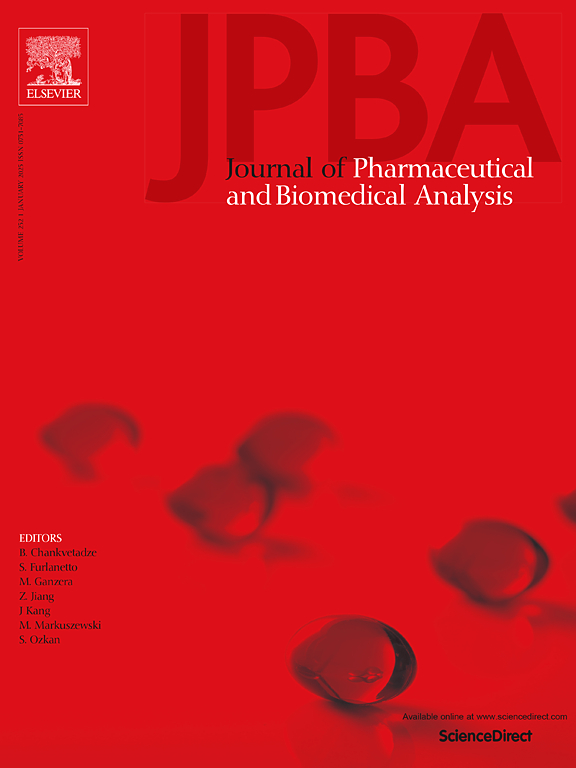Simultaneous determination of phenylalanine and tyrosine levels in human blood obtained by the dried spot technique for monitoring of patients with phenylketonuria
IF 3.1
3区 医学
Q2 CHEMISTRY, ANALYTICAL
Journal of pharmaceutical and biomedical analysis
Pub Date : 2025-03-18
DOI:10.1016/j.jpba.2025.116831
引用次数: 0
Abstract
Monitoring patients with phenylketonuria (PKU) requires accurately measuring phenylalanine and tyrosine levels in a small volume of blood samples obtained by the dried blood spot (DBS) technique. The aim was to study selected parameters influencing the quantitative results. Phenylalanine and tyrosine were extracted from DBS samples with methanol, and 5 internal standard introduction techniques were tested. Phenylalanine and tyrosine levels were measured in 6-mm discs punched from DBS, pre-punched 9-mm discs containing the entire DBS sample, and liquid blood by HPLC-MS-MS. Levels in 6-mm discs punched from DBS measured by HPLC-MS/MS were compared with those measured by the HPLC-FLD. The analytical parameters of the method are satisfactory, linearity in the range of 25–1200 μmol/L (LOD, LOQ and LLOQ values 0.2 μmol/L, 0.5 μmol/L and 3.8 μmol/L for phenylalanine, 0.5 μmol/L, 1.5 μmol/L and 5.1 μmol/L for tyrosine), within-run precision 1.8 %–3.7 % for phenylalanine, 1.9 %–2.7 % for tyrosine, between-run precision 4.7 %–5.9 % for phenylalanine, 4.1 %–5.4 % for tyrosine, recovery 93.8 %–100.4 % for phenylalanine and 93.7 %–99.1 % for tyrosine. Good agreement was found between phenylalanine and tyrosine concentrations in 6-mm discs punched from DBS (R = 0.896, p < 0.001, and R = 0.907, p < 0.001, respectively), pre-punched 9-mm discs containing the entire DBS sample (R = 0.960, p < 0.001, and R = 0.950, p < 0.001, respectively) and liquid blood, as well as between phenylalanine and tyrosine concentrations obtained by HPLC-MS/MS and HPLC-FLD (R = 0.968, p < 0.001, and R = 0.984, p < 0.001, respectively). The presented method is suitable for monitoring patients with PKU.
求助全文
约1分钟内获得全文
求助全文
来源期刊
CiteScore
6.70
自引率
5.90%
发文量
588
审稿时长
37 days
期刊介绍:
This journal is an international medium directed towards the needs of academic, clinical, government and industrial analysis by publishing original research reports and critical reviews on pharmaceutical and biomedical analysis. It covers the interdisciplinary aspects of analysis in the pharmaceutical, biomedical and clinical sciences, including developments in analytical methodology, instrumentation, computation and interpretation. Submissions on novel applications focusing on drug purity and stability studies, pharmacokinetics, therapeutic monitoring, metabolic profiling; drug-related aspects of analytical biochemistry and forensic toxicology; quality assurance in the pharmaceutical industry are also welcome.
Studies from areas of well established and poorly selective methods, such as UV-VIS spectrophotometry (including derivative and multi-wavelength measurements), basic electroanalytical (potentiometric, polarographic and voltammetric) methods, fluorimetry, flow-injection analysis, etc. are accepted for publication in exceptional cases only, if a unique and substantial advantage over presently known systems is demonstrated. The same applies to the assay of simple drug formulations by any kind of methods and the determination of drugs in biological samples based merely on spiked samples. Drug purity/stability studies should contain information on the structure elucidation of the impurities/degradants.

 求助内容:
求助内容: 应助结果提醒方式:
应助结果提醒方式:


